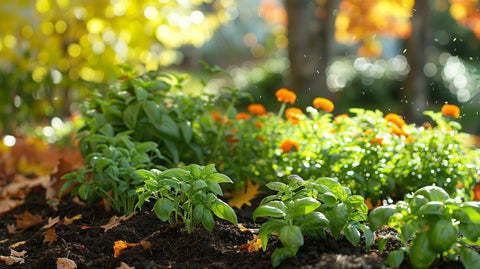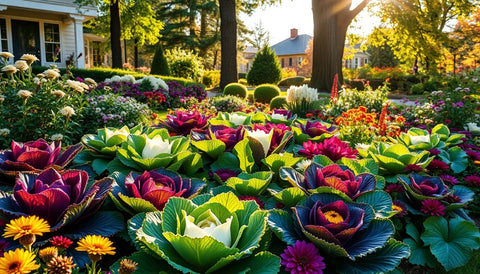- Introduction
- Why Plant Herbs in the Fall?
- Choosing the Right Herbs for Fall Planting
- Preparing Your Garden for Fall Herb Planting
- Planting Techniques
- Care and Maintenance of Fall Herbs
- Harvesting and Utilizing Fall Herbs
- Looking Ahead to Spring
- Conclusion
- Additional Resources
- Call to Action
Introduction
As the summer sun fades and crisp autumn air settles in, many gardeners may put their tools away, thinking the gardening season is over. But hold on! Fall is an opportune time to plant herbs that can thrive even as temperatures cool. Not only will these hardy plants extend your gardening joy, but they’ll also provide fresh flavors for your winter dishes. In this blog post, we’ll delve into the benefits of fall herb planting, the herbs that flourish in cooler weather, and how to set yourself up for a productive harvest.

Why Plant Herbs in the Fall?
A. Cooler Weather Advantages
When temperatures dip, plants often face less stress. This stress relief allows for stronger root development, making them well-prepared for the colder months ahead. Plus, the cooler air means fewer pests, which is a win-win for your garden!
B. Extended Growing Season
Imagine stepping into your garden for a taste of fresh cilantro or parsley in December! Fall-planted herbs can continue to grow and produce, giving you a delightful bounty right when you need it.
C. Preparing Soil for Spring
Planting herbs in the fall isn't just beneficial for your palette; it’s also great for your soil. Fall planting helps improve soil structure and nutrient levels, setting the stage for a flourishing spring garden.
Choosing the Right Herbs for Fall Planting
A. Hardy Herbs That Thrive in Cooler Temperatures
Certain herbs are perfect companions for fall planting. Hardy herbs like cilantro, parsley, chives, thyme, and sage enjoy the refreshing chill and often taste even better after a touch of frost!
B. Semi-Hardy Herbs That Can Tolerate Light Frost
If you're looking for more variety, consider dill and mint. These semi-hardy herbs can weather lighter frosts, offering flavors that add zesty flair to dishes.
C. Seasonal Considerations
Before diving in, check your geographic zone and frost dates. Knowing your local climate will guide your planting decisions and give you the best chance of success.

Preparing Your Garden for Fall Herb Planting
A. Soil Preparation
Healthy soil is crucial for healthy plants. Test your soil’s pH and nutrient levels and amend it with organic matter or specific fertilizers to create a nutrient-rich environment.
B. Choosing the Right Location
Location is key! Ensure the chosen spot receives ample sunlight—most herbs crave 6-8 hours per day. Drainage is essential too; soggy roots can spell disaster.
Planting Techniques
A. Direct Sowing vs. Transplanting Seedlings
You’ve got options! Direct sowing is quick and easy, while transplanting seedlings gives you more control over spacing. Consider what works best for you.
B. Proper Spacing and Depth
When planting, follow guidelines for each herb. Some may need more breathing room than others. Researching optimal depth ensures you won’t bury your herbs too deep.
C. Watering and Mulching Strategies
As temperatures drop, moisture needs change. Monitor your herbs and consider mulching to retain soil moisture and regulate temperature fluctuations.

Care and Maintenance of Fall Herbs
A. Watering Needs as Temperatures Fluctuate
Monitor your herbs, especially during dry spells. They may not need as much water as summer, but they still appreciate hydration to thrive.
B. Fertilizing During the Fall Months
Light fertilization can help your herbs before winter. Use slow-releasing organic fertilizers to provide nutrients over time without overwhelming them.
C. Protecting Herbs from Frost
Frost can be tricky! Use row covers, cloches, or cold frames to shield your tender herbs when temperatures dip below freezing.
Harvesting and Utilizing Fall Herbs
A. Best Practices for Harvesting Herbs
Timing is everything! Harvest herbs in the morning for the best flavor. Use sharp scissors to clip sprigs, and always leave some growth for continued production.
B. Ways to Use and Preserve Your Herbs
Fresh herbs are fantastic, but don't let them go to waste! Drying, freezing, or crafting herb-infused oils are excellent ways to preserve your harvest.

Looking Ahead to Spring
A. Benefits of a Fall Herb Garden for Spring Planting
A fall herb garden not only improves soil health but can also yield early harvests of perennial herbs come spring.
B. Planning for Spring Herb Expansion
Got plans for spring? Consider companion planting with your fall herbs to create a harmonious garden ecosystem.
Conclusion
Planting herbs in the fall is a game-changer for any gardening enthusiast. It extends your harvest and improves soil for the future. So, grab your tools and embrace the beauty of fall gardening! We'd love to hear your experiences and tips in the comments below.






























Comments (0)
There are no comments for this article. Be the first one to leave a message!